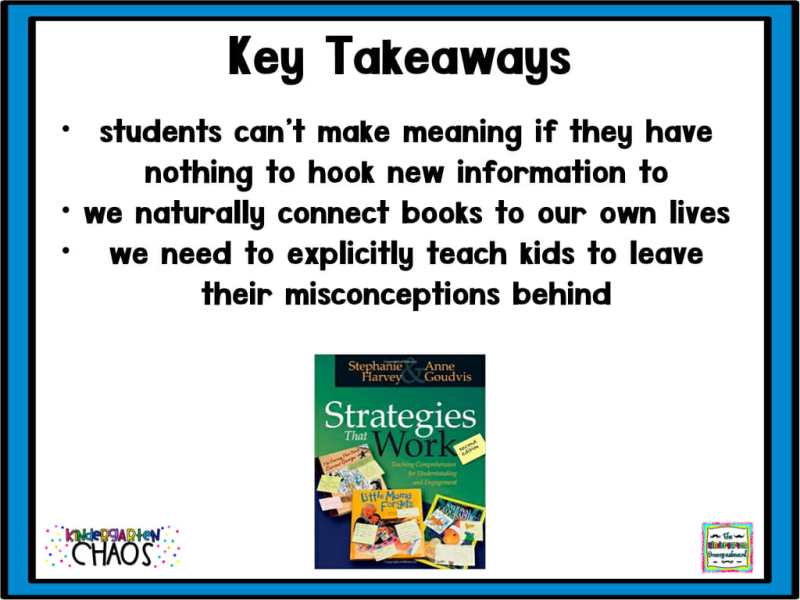We’re continuing our summer book study of the book Strategies That Work! I have learned so much about reading comprehension and have some great new ideas and strategies to implement in my class. Today we’re discussing chapter 7 which is all about the importance of background knowledge and making connections when we read. I’m excited to share some of our favorite background knowledge activities with you!
This chapter is particlulary relevant to me because background knowledge is a major factor in my classroom and there has been a struggle between teachers and administration about how much background knowledge to provide!

Background Knowledge Key Takeaways

Background Knowledge: My Classroom
My classroom is 95% ELL. A majority of my students arrive in my classroom speaking little to no English. This means they lack background knowledge or schema for many of the required anchor texts we use. As a teacher, we want to provide with the background knowledge to succeed. But is there such a thing as too much background knowledge? This was the point where I was challenged by administration. After reading this chapter, I feel that the more background knowledge we can provide, the better. In this chapter, the authors state: “If readers have nothing to hook new information to, it’s pretty hard to construct meaning.” So I feel very obligated to giving my students the background knowledge necessary to hook their new learning to.
Background Knowledge Activities: Schema Maps
As I was reading this chapter, one thing kept popping into my mind: our research projects and our schema maps. As I read the importance of “getting their brains ready to take in new information…” and “explicitly teaching kids to leave their misconceptions behind..” I felt validated knowing that we are on the right track.

Our research projects are a staple of our classroom curriculum. These research projects are how we integrate science and social studies standards and content into our literacy block. We are learning how to research and write while learning to think and make connections.
Schema Maps
Each of our research projects starts with a schema map. Schema maps are one of the best background knowledge activities we use! Students know that schema is “what we already know or think we know” about a topic. This is my way of getting some great insight into their background knowledge about a topic and their misconceptions about a topic. As we share our schema or background knowledge, we record them on sticky notes and place them in the schema section.

As we work through the research project, we add our new learning using sticky notes. At the end of the research project, we revisit our schema and address misconceptions. This is where we explicitly teach them to leave their misconceptions behind and make room for new learning. We achieve this by physically moving the sticky note from schema to misconceptions. As we do this we are discussing WHY this is a misconception. We replace the misconception with our new learning! With this part of the schema map process, we’re modeling how thinking change and we’ve come across new and more accurate knowledge!



Another way we use our research projects and our Read It Up creations is to move behind simply recalling information to thinking about what we’re learning. We are really trying to push our kids to discuss and think about material in more critical ways.
When using our research projects, we try to do this with their writing. As we research a topic, we record information on a graphic organizer. Students then use that information to write about what they’ve learned. When doing this, we’re pushing them to write the fact and then connect that fact to additional information or ideas.


Making Connections
Another area that was discussed in this chapter was making connections: text to self connections, text to text connections and text to world connections. The authors suggest to start small with those text to self connections and move to the larger connections. I feel like our kids make some great text to self and text to text connections. So what we try to do is move this into a writing activity. This is a key component of our Read It Up creations. For each story we read, the students have to write about something that connects them with the story. A trip to the beach, being scared, hurt feelings etc.


Engagement
Finally, one point might missed in this chapter and it’s something we need to remember: ENGAGEMENT! Sometimes our students make what the author calls “connections in common” which don’t do much to enhance understanding BUT DO LEAD TO ENGAGEMENT! And that is so vital. If our students aren’t engaged and excited about a text, they won’t make more meaningful connections and build comprehension. Let them be engaged! Let them be excited!
For more information on our research projects, visit this post:
For more on our Read It Up resources, visit this post:
Join us on Facebook to keep the conversation going! We will be sharing our thoughts on the chapter and this question:

Make sure to visit Abby at Kindergarten Chaos for her thoughts on this chapter!





